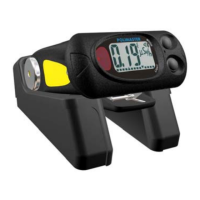In case the alarm is actuated automatic calibration is not performed, therefore it is
recommended that the user re-calibrate the instrument manually to accommodate the
changed background. You can also change the n-coefficient to alter the sensitivity
threshold.
When the background radiation decreases (when the instrument is moved from a
higher level of background radiation to a lower one) the instrument will be re-calibrated
automatically (if auto-calibration is enabled). This increases the instrument’s sensitivity
and is very useful.
To update the background radiation levels and recalculate the thresholds, press
and hold down the Mode button until the message “CAL” appears in the display
window. The unit is now acquiring new background. In total, this process requires
60 seconds. When the LCD screen display returns to the normal numeric display, the
unit has modified its background radiation levels to the new environment and is ready
for normal operation.
5.5 Alarms
Alarm levels in the Search Mode are derived from the ambient background.
When the instrument runs through background calibration, it acquires a background
reading and calculates the alarm levels automatically based on the value of n coefficient
set by the user.
The value of n coefficient may be set in the range of 1.0 to 9.9 through every 0.1.
The smaller is the value of n coefficient, the more sensitive is the instrument to changes
in background radiation, and however this also increases the rate of false alarms (false
positives). The larger is the value of n coefficient, the less sensitive unit becomes to
minor changes in radiation background and responds only to large radiation field
variations (intensive radiation sources nearby) and probability of false alarms decreases.
5.5.1 False Alarms
All radiation detection systems experience false alarms. The number of false alarms
depends on many factors including changes in the ambient background radiation level
as well as changes to the system setup. Under normal conditions, if there are no
mechanical impacts and the manufacturer’s settings are used, the user should expect a
maximum of one false alarm per ten hours of operation.
Occasionally, the instrument will “chirp” signaling to the user that the unit is still
functioning. Such alarms are irregular and can, therefore, be easily distinguished from true
alarm signals produced by the gamma radiation sources.
5.6 Exceeding instruments temperature operation range
When the temperature inside the instrument exceeds the upper limit, the message
“ot” will be displayed. The instrument functionality will be restored after its
temperature will come back to the normal operation range.
13

